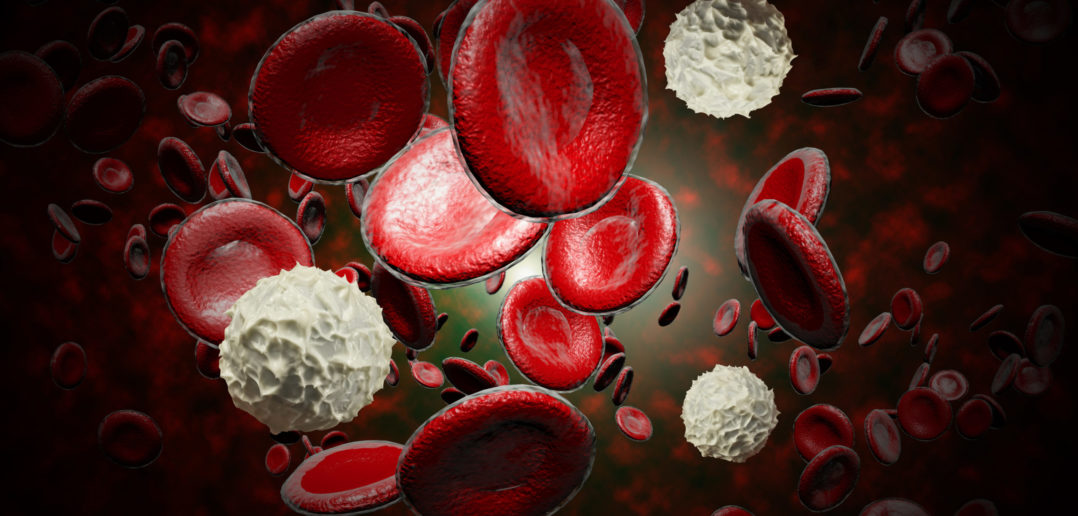News
New Therapy Harnesses Patients’ Blood Cells to Fight Tumors
April 10, 2023

Healthy human red and white bloodcells in close up 3d graphics render
Noninvasive approach is fast, cost-effective and could be used to treat a variety of cancers
*Story originally published by Northwestern Medicine Feinberg School of Medicine.
Adoptive cell therapy (ACT) has become a promising immunotherapy tool to help treat advanced melanoma. The therapy, which harnesses immune cells collected from the patient’s own tumors, could provide a new treatment option to cancer patients, potentially bypassing radiation therapies and harsh chemotherapy drugs.
For the first time, in research published in Nature Biomedical Engineering, Northwestern University scientists have discovered it is possible to isolate a tumor’s attack cells non-invasively from blood, rather than from tumors. The finding opens the door for ACT to treat harder-to-reach cancer types and makes it a more viable option for hospitals.

“We started asking questions about whether the immune cells that go into tumors come back out, and if you could find them in the bloodstream,” said Shana O. Kelley, PhD, the paper’s corresponding author. “We didn’t know if we’d be able to find them or if we could see enough of them to even study them. Sure enough, they’re in the blood. This is the first time these cells have been studied in this context.”
Kelley is the Neena B. Schwartz Professor of Chemistry and Biomedical Engineering at the Northwestern University Weinberg College of Arts and Sciences and McCormick School of Engineering, and a professor of Biochemistry and Molecular Genetics at Northwestern University Feinberg School of Medicine. She also is president of the Chan Zuckerberg Biohub Chicago.
The study builds on previous work from Kelley’s lab that was published last year in the same journal. In the previous study, Kelley and her team treated mice with their own immune cells gathered from a mass, which dramatically shrunk their tumors, compared to traditional cell-therapy methods.
The 2022 paper also detailed the novel method used to isolate and multiply tumor-infiltrating lymphocytes (TILs), a process that efficiently sorts through and harvests cells to recover 400% more than current approaches, ultimately making the anti-cancer response stronger.
Into the tumor and then out again
By removing and processing melanoma tumors, scientists have found TILs within them. But sometimes removing tumors to harvest TILs can pose significant risks to patients, leaving no path to harness ACT to fight many types of cancer.
Kelley wondered if TILs might exist elsewhere in the body — outside tumors.
After finding TIL-like lymphocytes — or circulating tumor-reactive lymphocytes (cTRLs) — in animal blood, the team tested whether or not cTRLs had the same ability as TILs to kill tumor cells. Surprisingly, they did.
Across tumor cell types and animal models
To overcome another major stumbling point, after finding and profiling cTRLs, the Kelley lab used its novel technology platform to isolate and then replicate only the best tumor fighters.
Again, cTRLs effectively leveled their competition by engaging in direct, “hand-to-hand” combat with tumor cells.
“Engineering-based tools allow you to do things that open up new areas of biology,” said Shana O. Kelley, the paper’s corresponding author. “We could see using the platform at any major medical center, so you could reach a significant number of patients. The platform we use to capture cells is very fast, which brings the cost down, and medical centers are comfortable handling blood.”
Scientists also found cTRLs not just in melanoma models, but in colon, lung and breast cancer, each tumor expressing a unique signature that TILs bind to.
Paving new roads in cell therapy
Kelley has spun out the new technology into health tech startup CTRL Therapeutics, which will petition the U.S. Food and Drug Administration to move the platform into clinical trials.
“This new breakthrough leads us to ask some exciting questions about how early cTRLs appear in blood,” Kelley said. “Could we diagnose and treat cancer earlier using these cells?”
Kelley also is a member of the International Institute for Nanotechnology, the Chemistry of Life Processes Institute, the Simpson Querrey Institute for BioNanotechnology and the Robert H. Lurie Comprehensive Cancer Center of Northwestern University.
The paper’s first author was Zongjie (Daniel) Wang, PhD, a University of Toronto professor in the department of electrical and computer engineering. The study was supported by the Canadian Institutes of Health Research (grant no. FDN-148415) and the Collaborative Health Research Projects program (CIHR/NSERC partnered). This research was supported in part by the McCormick Catalyst Fund at Northwestern University and is part of the University of Toronto’s Medicine by Design initiative, which receives funding from the Canada First Research Excellence Fund.
Kelley has a financial interest in and affiliations with CTRL Therapeutics. Northwestern has financial interests (equities, royalties) in CTRL Therapeutics.